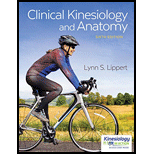
a.
To complete: The blanks using the descriptive terminology.
Introduction: The scientific study related to non-human and human body movement is known as
a.
Answer to Problem 1RQ
Correct answer: The sternum is anterior to the vertebral column.
Explanation of Solution
The sternum is also known as the breastbone. It is a long flat bone present in the center part of the chest. It basically forms the front part of the rib cage that connects the ribs through cartilage. It mainly protects the lungs, major blood vessels, and injury in the heart, which is found anterior to the vertebral column.
b.
To complete: The blanks using the descriptive terminology.
b.
Answer to Problem 1RQ
Correct answer: The calcaneus is on the posterior portion of the foot.
Explanation of Solution
In humans, the heel bone is known as the calcaneus. It is the foot tarsus bone that forms the heel part of the body. The calcaneus bone is found in the posterior part on the portion of the foot.
c.
To complete: The blanks using the descriptive terminology.
c.
Answer to Problem 1RQ
Correct answer: The hip is inferior to the chest.
Explanation of Solution
The hip region is located anterior and lateral to the gluteal region and inferior to the iliac crest. There are three pelvic bones that fuse to form the hip bone known as the acetabulum. The hip bone is found inferior in the chest region.
d.
To complete: The blanks using the descriptive terminology.
d.
Answer to Problem 1RQ
Correct answer: The femur is proximal to the tibia.
Explanation of Solution
The femur bone is also known as the thigh bone that is considered as the strongest bone in the body. This bone is involved in the jumping, walking, and sitting activities. The femur comprises two epiphyses and one diaphysis. The location of the femur is found proximal to the tibia.
e.
To complete: The blanks using the descriptive terminology.
e.
Answer to Problem 1RQ
Correct answer: The radius is on the lateral side of the forearm.
Explanation of Solution
One of the two large bones of the forearm is basically known as the radius. The radius takes part in two major joints; the wrist joint and the elbow joint. The radius is present lateral to the forearm.
Want to see more full solutions like this?
Chapter 1 Solutions
Clinical Kinesiology and Anatomy
 Human Anatomy & Physiology (11th Edition)BiologyISBN:9780134580999Author:Elaine N. Marieb, Katja N. HoehnPublisher:PEARSON
Human Anatomy & Physiology (11th Edition)BiologyISBN:9780134580999Author:Elaine N. Marieb, Katja N. HoehnPublisher:PEARSON Biology 2eBiologyISBN:9781947172517Author:Matthew Douglas, Jung Choi, Mary Ann ClarkPublisher:OpenStax
Biology 2eBiologyISBN:9781947172517Author:Matthew Douglas, Jung Choi, Mary Ann ClarkPublisher:OpenStax Anatomy & PhysiologyBiologyISBN:9781259398629Author:McKinley, Michael P., O'loughlin, Valerie Dean, Bidle, Theresa StouterPublisher:Mcgraw Hill Education,
Anatomy & PhysiologyBiologyISBN:9781259398629Author:McKinley, Michael P., O'loughlin, Valerie Dean, Bidle, Theresa StouterPublisher:Mcgraw Hill Education, Molecular Biology of the Cell (Sixth Edition)BiologyISBN:9780815344322Author:Bruce Alberts, Alexander D. Johnson, Julian Lewis, David Morgan, Martin Raff, Keith Roberts, Peter WalterPublisher:W. W. Norton & Company
Molecular Biology of the Cell (Sixth Edition)BiologyISBN:9780815344322Author:Bruce Alberts, Alexander D. Johnson, Julian Lewis, David Morgan, Martin Raff, Keith Roberts, Peter WalterPublisher:W. W. Norton & Company Laboratory Manual For Human Anatomy & PhysiologyBiologyISBN:9781260159363Author:Martin, Terry R., Prentice-craver, CynthiaPublisher:McGraw-Hill Publishing Co.
Laboratory Manual For Human Anatomy & PhysiologyBiologyISBN:9781260159363Author:Martin, Terry R., Prentice-craver, CynthiaPublisher:McGraw-Hill Publishing Co. Inquiry Into Life (16th Edition)BiologyISBN:9781260231700Author:Sylvia S. Mader, Michael WindelspechtPublisher:McGraw Hill Education
Inquiry Into Life (16th Edition)BiologyISBN:9781260231700Author:Sylvia S. Mader, Michael WindelspechtPublisher:McGraw Hill Education





